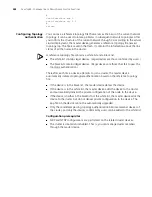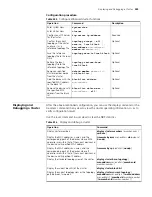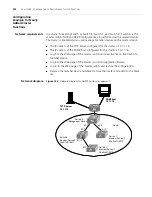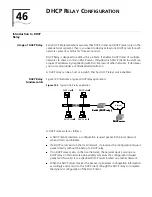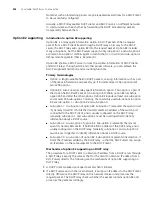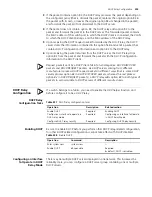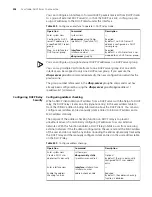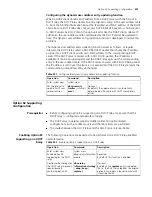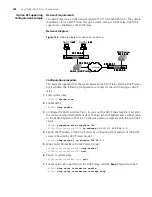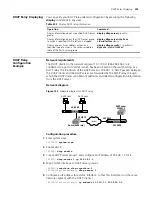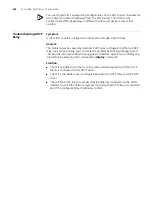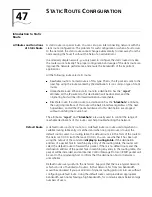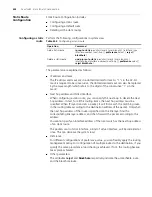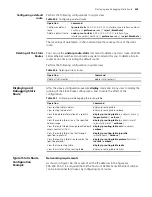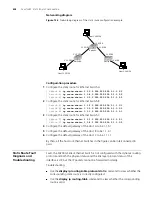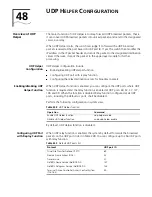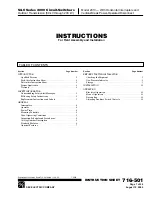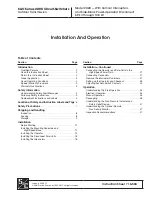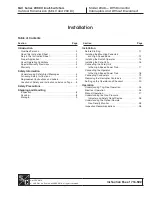
402
C
HAPTER
47: S
TATIC
R
OUTE
C
ONFIGURATION
Static Route
Configuration
Static Route Configuration includes:
■
Configuring a static route
■
Configuring a default route
■
Deleting all the static routes
Configuring a static
route
Perform the following configurations in system view.
The parameters are explained as follows:
■
IP address and mask
The IP address and mask are in a dotted decimal format. As “1”s in the 32-bit
mask is required to be consecutive, the dotted decimal mask can also be replaced
by the
mask-length
(which refers to the digits of the consecutive “1”s in the
mask).
■
Next hop address and NULL interface
When configuring a static route, you can specify the
next-hop
to decide the next
hop address. In fact, for all the routing items, the next hop address must be
specified. When IP layer transmits a packet, it will first search the matching route
in the routing table according to the destination address of the packet. Only when
the next hop address of the route is specified can the link layer find the
corresponding link layer address, and then forward the packet according to this
address.
You cannot specify an interface address of the local switch as the next hop address
of an static route.
The packets sent to NULL interface, a kind of virtual interface, will be discarded at
once. This can decrease the system load.
■
Preference
For different configurations of
preference-value
, you can flexibly apply the routing
management policy. For configuration of multiple routes to the destination, if you
specify the same precedence, load sharing is achieved. If not, the routing backup
takes place achieved.
■
Other parameters
The attributes
reject
and
blackhole
respectively indicate the unreachable route
and the blackhole route.
Table 344
Configuring a static route
Operation
Command
Add a static route
ip route-static
ip-address
{
mask
|
mask-length
} {
interface-type
interface-number
|
next-hop
} [
preference
value
] [
reject
|
blackhole
]
Delete a static route
undo ip route-static
ip-address
{
mask
|
mask-length
} [
interface-type interface-number
|
next-hop
] [
preference
value
] [
reject
blackhole
]
Summary of Contents for 4200G 12-Port
Page 10: ...8 CONTENTS...
Page 14: ...4 ABOUT THIS GUIDE...
Page 46: ...32 CHAPTER 5 LOGGING IN THROUGH WEB BASED NETWORK MANAGEMENT SYSTEM...
Page 48: ...34 CHAPTER 6 LOGGING IN THROUGH NMS...
Page 60: ...46 CHAPTER 9 VLAN CONFIGURATION...
Page 64: ...50 CHAPTER 10 MANAGEMENT VLAN CONFIGURATION...
Page 80: ...66 CHAPTER 13 GVRP CONFIGURATION...
Page 98: ...84 CHAPTER 15 LINK AGGREGATION CONFIGURATION...
Page 112: ...98 CHAPTER 18 MAC ADDRESS TABLE MANAGEMENT...
Page 126: ...112 CHAPTER 19 LOGGING IN THROUGH TELNET...
Page 162: ...148 CHAPTER 20 MSTP CONFIGURATION...
Page 274: ...260 CHAPTER 29 IGMP SNOOPING CONFIGURATION...
Page 276: ...262 CHAPTER 30 ROUTING PORT JOIN TO MULTICAST GROUP CONFIGURATION...
Page 298: ...284 CHAPTER 33 SNMP CONFIGURATION...
Page 304: ...290 CHAPTER 34 RMON CONFIGURATION...
Page 338: ...324 CHAPTER 36 SSH TERMINAL SERVICES...
Page 356: ...342 CHAPTER 38 FTP AND TFTP CONFIGURATION...
Page 365: ...Information Center Configuration Example 351 S4200G terminal logging...
Page 366: ...352 CHAPTER 39 INFORMATION CENTER...
Page 378: ...364 CHAPTER 40 BOOTROM AND HOST SOFTWARE LOADING...
Page 384: ...370 CHAPTER 41 Basic System Configuration and Debugging...
Page 388: ...374 CHAPTER 43 NETWORK CONNECTIVITY TEST...
Page 406: ...392 CHAPTER 45 CONFIGURATION OF NEWLY ADDED CLUSTER FUNCTIONS...

